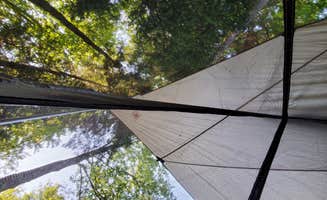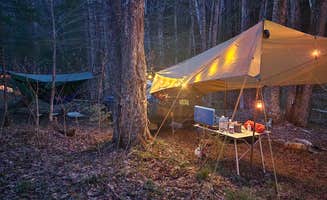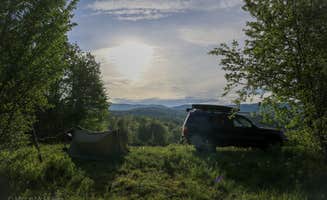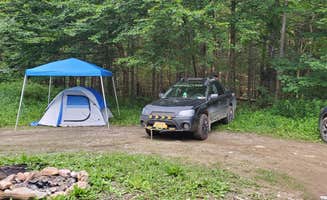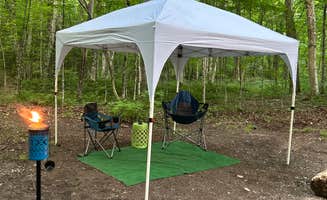Primitive camping near West Hartford, Vermont centers primarily around the Green Mountain National Forest, a public land system covering elevations between 900-3,500 feet with numerous brook-fed valleys. During winter months, many dispersed sites become inaccessible due to seasonal road closures by the U.S. Forest Service. Camping options range from streamside locations to open meadow sites offering mountain views.
What to do
Hiking nearby trails: Several sites provide convenient access to trail systems. At Green Mountain National Forest FR207, one camper noted "Nearby Clark Brook Trail is a 3 mile hike connecting with the AT/LT." Winter visitors have opportunities for solitude and wildlife viewing, with one camper reporting they "woke up to two moose nearby the morning I was leaving."
Swimming in natural pools: The region offers multiple swimming options during summer months. Route 100 Dispersed Camping provides "right next to Mad River with a area to walk down into a swimming hole," according to a visitor. Water activities remain popular despite limited facilities at most sites.
Wildlife observation: The forest area supports diverse wildlife. Campers should store food properly as bears are active in the region. One camper at Tripoli Road noted they "didn't see any but saw plenty of evidence" of bears during their stay, making proper food storage essential for safety.
What campers like
Privacy between sites: Many dispersed camping areas offer good separation between sites. At Patterson Brookside camp on West Hill Road, "there are a handful of sites to camp at along the river here, each offering a slightly different experience." These sites provide a more isolated experience than developed campgrounds.
Night sky viewing: The lack of light pollution creates excellent stargazing conditions. A camper at Green Mountain Camp on Town Road 11 mentioned "The campground was very quiet at night except for an occasional owl hoot," providing ideal conditions for astronomy enthusiasts.
Sound of flowing water: Streamside sites offer natural sound barriers. Visitors appreciate the calming effect of water sounds, with one camper noting "Gorgeous stream/river... love the river sounds" at one location. Water access also provides practical benefits for filtering drinking water at primitive sites.
What you should know
Site closure risks: Rangers actively manage overused areas. According to a recent visitor at Green Mountain National Forest Texas Falls Primative campsites, sites "were well used with some litter. We packed out what we could find." Another camper reported that "some areas are being shut down from abuse" due to improper waste disposal.
Winter accessibility: Many roads close seasonally due to snow. One camper noted an area "is closed in the winter due to snow, by the GMNF." For winter camping attempts, vehicle preparation is essential as "entrance and exit are a little steep and tricky in the winter, lot wasn't plowed so AWD/4x4 and good ground clearance are recommended."
Limited facilities: Most sites lack basic amenities. A visitor observed "There is no electricity, no cell coverage, not outhouses in this area. Be prepared to pack out everything you bring in." Visitors must be self-sufficient with water filtration equipment, waste disposal solutions, and emergency supplies.
Tips for camping with families
Site selection criteria: Families should choose sites with manageable access. Areas with "great tree coverage to easily set up a tarp" provide better shelter options during unexpected weather changes. Look for established sites with minimal hiking distance from parking areas.
Wildlife awareness: Teach children about proper food storage and wildlife safety. Several reviews mention evidence of bears in the region. A visitor to Last light on Michigan Brook advises "Keep it clean!" to minimize wildlife encounters and preserve site quality.
Water access considerations: Sites near water provide both recreation and practical benefits. One camper noted "All pretty much have access to the streams" at their location, which offers natural entertainment for children but requires supervision. Flowing water can be both an amenity and a safety concern with younger children.
Tips for RVers
Road clearance requirements: Many forest roads present challenges for larger vehicles. One visitor reports "This is not a place to go without at least 9" of ground clearance." Another notes that "some sports have dips in the ground" that can cause problems for longer wheelbase vehicles.
Parking area limitations: RVers should scout sites before attempting access. A visitor observed "Main lot has plenty of parking, perfect for car camping," but many areas have limited turning radius. Most primitive sites accommodate smaller camper vans rather than full-size RVs.
Seasonal road conditions: Spring mud season creates additional challenges. A camper mentioned "The ground gets soft during mud season," which particularly affects heavier vehicles. Fall and mid-summer typically provide the best road conditions for RV access to more remote sites.


